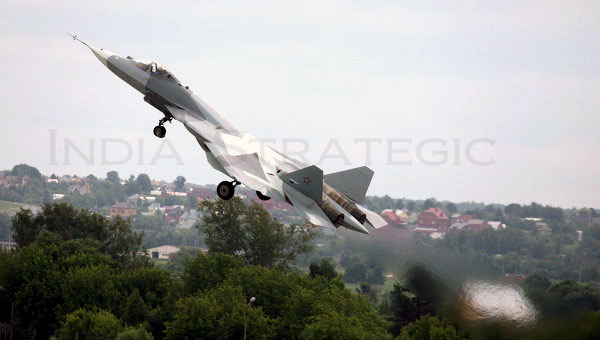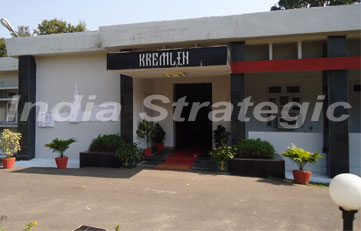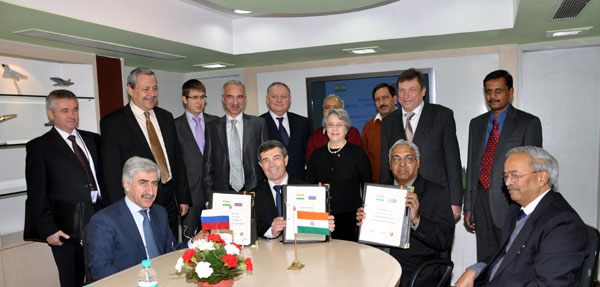|
Under the project, India's Hindustan Aeronautics
Limited (HAL) and Russia's United Aircraft Corporation
(UAC) will set up a 50:50 joint venture on the
lines of the Indo-Russian BrahMos Aerospace, which
is manufacturing the world's only operational
supersonic land and ship attack missile. But unlike
the BrahMos venture, HAL, aided by India's Defence
Research & Development Organisation (DRDO),
will work jointly to develop various systems for
the aircraft, deriving on each other’s strengths
and capabilities.
The Russians for instance, will provide the
engines to propel the aircraft at supersonic cruise
speeds - without sustained use of afterburner
- while the Indian side will help in design and
guidance systems and onboard software. Notably,
on all the Su 30 MKIs that the IAF has acquired
or is acquiring, the source codes and software
are proprietary to DRDO which developed them.
To facilitate joint development and production,
military technology scientists and IAF officials
would be exchanged and sent to each other’s
facilities.
Chief of Air Staff of the Indian Air Force (IAF),
Air Chief Marshal P V Naik, told India Strategic
that IAF plans to acquire 250 FGFAs. Ministry
of Defence (MoD) officials have earlier said that
the number could go up to 300, but a statement
issued after the signing ceremony said the number
could be “over 200 to 250 aircraft.”
Each aircraft could eventually cost $ 100 million,
and India would share Intellectual Property Rights
(IPR) on the aircraft’s exports to other
countries.
India and Russia are initially contributing $
six billion, and the Russians should start transferring
technology on the work done so far to HAL. Teams
from HAL and DRDO, including HAL Chairman Ashok
Nayak and DRDO's Chief Controller and distinguished
scientist Dr Prahlada have already visited Moscow
a few times to witness the progress of the aircraft,
including its flight demonstrations..

Mr Nayak told India Strategic that
HAL would be investing $ 6 billion to develop
the project and acquire the technology.
He also said that the headquarters for the FGFA
would be located at HAL, Bangalore.
The exact cost of each aircraft for India could
be around $ 100 million, and the weapons package
would be extra.
Sources in Moscow told India Strategic
that at the moment, the single aircraft, in prototype
version, has only limited stealth capabilities
and is powered by two tweaked Al-31FP engines,
used in the Su 30 aircraft, engines but new engines
are under development. The first prototype is
designated Sukhoi PAK T-50, and a second prototype
is scheduled to take to the air in 2011.
The agreement, described as a “contract,”
was signed by HAL Chairman & Managing Director
Ashok Nayak and Director (D&D) NC Agarwal
on behalf of India and Rosoboronexport General
Director A Isaykin and RAC Mig & Sukhoi General
Director M Pogosyan on behalf of Russia.
Air Chief Marshal Naik told India Strategic
that IAF expected the first deliveries of the
aircraft in 2016 or 2017 as a lot of work had
already been done on the development of this aircraft
by the Russians. The basic agreement to co-develop
the aircraft was signed in 2007.
Although the Indian Air Force has acquired most
of its combat and transport aircraft from the
Soviet Union, and then its successor state Russia,
in terms of value the FGFA deal is the single
biggest ever for India with any country, Russia
included.
Said the MoD statement: “Today's contract
is only the first in a series of such contracts
which will cover different stages of this complex
programme. The total cost including options and
the value of production aircraft will make this
the biggest Defence programme ever in the history
of India involving production of over 200-250
aircraft.”
In terms of numbers however, India purchased
more than 400 Mig 21s from the Soviet Union, and
has already purchased or placed orders for 272
Su 30 MKI air dominance fighters with Transfer
of Technology (ToT) to manufacture them progressively
in India. As the IAF is short of combat jets,
due to the political paralysis in defence acquisitions
triggered by the VP Singh government in 1989,
it is likely for the IAF to go in for a total
of 350 Su 30 MKIs by placing more orders in the
coming years.
IAF is also looking at acquiring 126 plus 63
Medium Multi Role Combat Aircraft (M-MRCAs) as
soon as possible and it has already submitted
its report to the government on its technical
evaluation of the six aircraft in fray in this
regard. Although Air Chief Marshal Naik hopes
that the MoD could finalise and approve the selection
within the first half of 2011, there are related
issues on ToT and offsets that are taking time
to be resolved.
IAF is keen to build a technological edge in
reach and precision in any possible future aerial
engagements, and that is why there is emphasis
on new generation capabilities like the AESA and
other combat radars. The Su 30 MKI, although an
excellent aircraft, does not have some of these
capabilities, but the FGFA will.
And there are plans to put this combat radar
technology on the Su 30 MKIs also some time later.
Undoubtedly, the United States is by far the
leader in such capabilities, but to what extent
it would share them with India, needs thoughtful
consideration.
There is indeed a concern in this regard at
the Air Headquarters, where some believe that
the Europeans would offer more technology than
the Americans, even though the latter have an
undeniable lead.
The Soviet Union, and Russians, have had a good
record in aerospace but in terms of avionics and
AESA capabilities, they are much behind the US
and Europe, and according to Russian reports,
some 90 per cent of Russia’s own defence
equipment needs to be replaced and modernized
to 21st century capabilities.
It may be recalled however that it was the Soviet
Union which first sent a rocket into space, and
even the concept for the stealth aircraft was
first given in the 1960s by a Russian physicist,
Pyotr Ufimtse, who said that it would be the aerodynamics
and not the size of an aircraft that would define
its stealth capabilities to a radar US military
scientists successfully made use of this concept
by developing the F 22 Raptor and F 35 Lightning
II, and Russians are doing it now. The bigger
issues though on developing a modern, stealthy
aircraft are how to minimize its exhaust and heat
emissions even during super cruise.
The FGFA agreement with Russia, and possibly
M-MRCA deal with another western country, will
help India acquire some of these technologies
towards building an indigenous military industrial
base.
IAF officials are clear that capabilities like
the AESA are game changers, and imperative to
build capability towards deterrence, and to punish
an aggressor.
The agreement to jointly develop and manufacture
the 30-tonne FGFA was signed as part of the Indo-Russian
summit meetings between Prime Minister Dr Manmohan
Singh and the visiting President Dmitri Medvedev.
The two sides signed some 30 agreements, ranging
from cooperation in defence to space, science,
security and cultural exchange.
It may also be noted that the Soviet Union,
the predecessor of Russia, had sold aircraft,
tanks, guns, ships and submarines to India worth
more than USD 30 billion till 1990. Soviet engineers
also built the naval base at Vishakhapatnam, where
India is building its first nuclear submarine,
Arihant.
 Interestingly,
the hostel to house the Russian engineers at this
naval base was designated “Kremlin”
although it is used now by Indian engineers. Interestingly,
the hostel to house the Russian engineers at this
naval base was designated “Kremlin”
although it is used now by Indian engineers.
After 1990, despite the breakup of Soviet Union
into Russia and several other states, Moscow has
still managed to sell, or commit supplies, worth
nearly $ 20 billion, including India's biggest
combat jet aircraft order in the last 15 years
for 272 Sukhoi Su 30MKI fighters and 80 Mi 17
V5 multi role helicopters. Russia is also helping
India build Arihant, and two more nuclear submarines,
while it is set to deliver a Nerpa II class submarine
to India around March 2011 for a 10-year lease.
Although delayed and with costs increased to
more than double, Russia is also committed to
deliver the refurbished Admiral Gorshkov aircraft
carrier to the Indian Navy by December 2012. India
has agreed to wave off any penalties for the delay
so far and the Russian Government has given a
sovereign guarantee to ensure the aircraft carrier's
delivery by then.
According to an official statement issued after
the signing ceremony, the FGFA agreement "envisages
joint design and development" and that the
Sukhoi Design Bureau and Rosoboronexport would
be partners from the Russian side.
The statement said: “The aircraft to be
jointly developed is termed Perspective Multi-role
Fighter (PMF). PMF draws upon the basic structural
and system design of the Russian FGFA Technology
Demonstrator with modifications to meet IAF specifications
which are much more stringent. The broad scope
of bilateral cooperation during the joint project
covers the design & development of the PMF,
its productionization and joint marketing to the
third countries. Programme options include the
design & development of a twin seater variant
and the integration of an advanced engine with
higher thrust at a later stage.”.

|